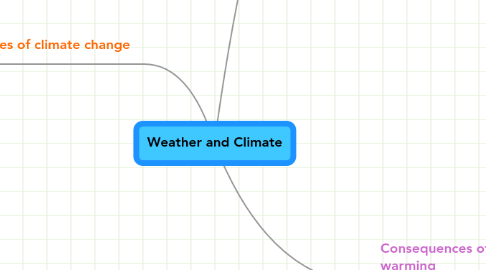
1. Causes of climate change
1.1. Start of industrial revolution (18th Century)
1.1.1. Increase in levels of carbon dioxide by 30%
1.1.2. Increase in levels of methane by 150%
1.1.3. Increase in levels of nitrous oxide by 15%
1.2. Enhanced greenhouse effect
1.2.1. Causes a rise in Earth's average temperature
1.2.1.1. Global warming
1.3. Increase in human activities
1.3.1. Greenhouse effect
1.3.1.1. Natural process whereby greenhouse gases absorb heat from the sun's rays and trap it in the atmosphere
1.3.1.2. More heat trapped due to increase in greenhouse gases
1.3.2. Greenhouse gases
1.3.2.1. Carbon dioxide
1.3.2.2. Methane
1.3.2.3. Nitrous oxide
1.3.2.4. Water vapour
1.4. Industrial activities
1.4.1. Rapid increase in use of fossil fuels
1.4.1.1. Vehicles
1.4.1.2. Factories
1.4.1.3. Power plants
1.4.2. Leads to the increase of
1.4.2.1. Carbon dioxide
1.4.2.2. Nitrous oxide
1.4.3. Usage of chemicals
1.4.3.1. Chloro-fluro Carbon (CFC)
1.4.3.1.1. Compounds that are harmful when broken down
1.4.3.2. Aerosol cans
1.4.3.3. Refrigerators
1.5. Large scale deforestation
1.5.1. Reduced amount of vegetation at an alarming rate
1.5.1.1. Timber
1.5.1.2. Mining
1.5.1.3. Create more land
1.5.2. Trees take in Carbon dioxide and gives out Oxygen
1.5.2.1. When more trees are cut, less carbon dioxide is taken in
1.5.2.1.1. Carbon dioxide levels increase
1.6. Agricultural activities
1.6.1. Wet rice cultivation
1.6.1.1. Use of inorganic fertilizers release
1.6.1.1.1. Methane
1.6.1.1.2. Nitrous oxide
1.6.2. Cattle ranching
1.6.2.1. Releases methane
2. Solutions taken
2.1. International
2.1.1. Mitigation
2.1.1.1. Government takes step to reduce greenhouse gases
2.1.1.2. Kyoto protocol
2.1.1.2.1. Agreed to reduce emissions by 5% in 2012
2.1.1.2.2. Signed in Japan in December
2.1.1.3. Montreal protocol
2.1.1.3.1. Limit the production and use of CFCs
2.2. National
2.2.1. Pass laws to help reduce the impact of climate change
2.2.1.1. Singapore NEA
2.2.1.1.1. Made it compulsory for all vehicles to pass a smoke emission test
2.2.1.1.2. Ensure gases emitted are within acceptable range
2.2.1.1.3. Must install catalytic convertors
2.3. Individual
2.3.1. Switching off lights and lamps when not in use
2.3.2. Reuse products like old bottles
2.3.3. Putting newpaper into recycling bins
2.3.4. Be informed of environmental activities
2.3.4.1. Earth Day 07.07.07
3. Consequences of global warming
3.1. Extreme weather conditions
3.1.1. Severe storms
3.1.1.1. Regions with wetter climate
3.1.1.1.1. Higher relative humidity
3.1.1.2. Warmer ocean temperatures
3.1.1.2.1. More intense tropical storms
3.1.2. Heat waves and droughts
3.1.2.1. Higher temperatures and evaporation rates
3.1.2.1.1. Lakes & rivers dry up
3.1.2.1.2. Less water vapour
3.1.2.2. Sahel region
3.1.2.3. Heat waves: A prolonged period of high temperatures
3.1.2.3.1. Europe
3.1.2.3.2. Milan, Italy
3.1.2.3.3. Cause forest fires
3.1.2.4. Forced animals to migrate
3.1.2.4.1. Extinction
3.1.2.4.2. Adelie Penguins
3.2. Melting ice and rising sea levels
3.2.1. Satellite images from space shows that glaciers are retreating
3.2.1.1. Caused sea levels to rise at an average rate of 1mm - 2mm a year
3.2.2. Arctic region
3.2.2.1. Ice caps cover much of Greenland
3.2.2.1.1. Due to global warming 50% of sea ice could disappear by 2050
3.2.3. South pole (Covered by Antarctica)
3.2.3.1. Contain 70% of Earth's ice
3.2.3.1.1. Could melt due to global warming
3.2.4. Low-lying coastal countries
3.2.4.1. Vulnerable to rising sea levels
3.2.4.2. Lives and property of an estimated 100 million people are threatened by the possibility of going below the rising sea levels
3.2.5. Ice melting in the arctic region
3.2.5.1. Shrinking ice cover
3.2.5.1.1. 1979
3.2.5.1.2. 2003
3.2.5.1.3. No ice to reflect heat back to space
3.2.5.1.4. Large open oceans absorb more heat
